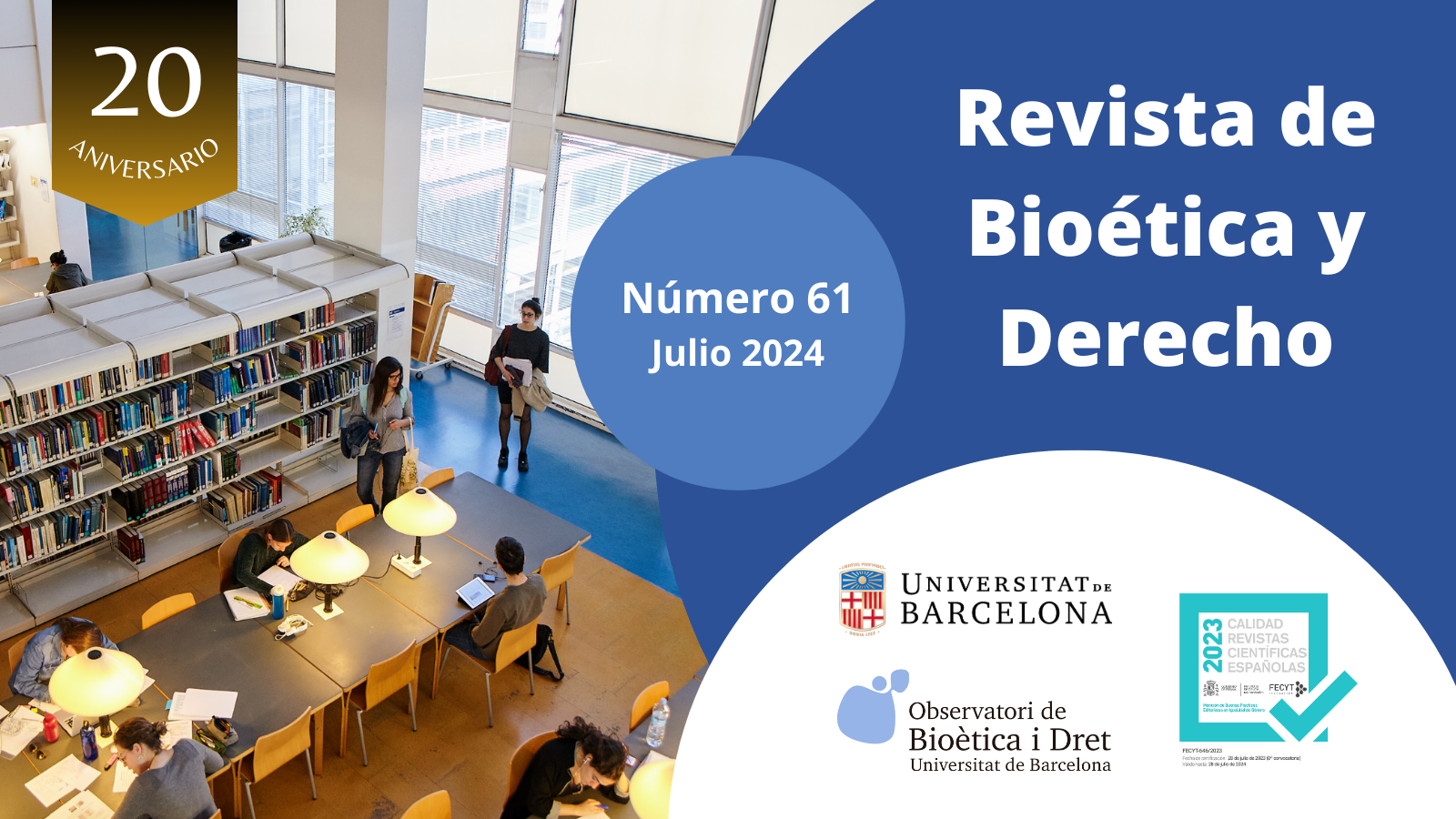Surrogacy and mobility of human biomaterials
DOI:
https://doi.org/10.1344/rbd2024.61.45180Keywords:
surrogacy, mobility of human biomaterials, human mobility, reproductive tourism, double parameterAbstract
The mobility of human biomaterials in Spain is prohibited to be used for surrogacy. Surrogacy is also not permitted in the Spanish legal system. Despite both prohibitions, many people travel abroad to countries where surrogacy is legal to have a baby using this technique. However, it is impossible to verify whether human biomaterials are not transferred to other countries to be used in surrogacy processes. This case perfectly illustrates the double ethical and legal parameter that the Spanish legal system has regarding reproductive medicine in general and against the mobility of human biomaterials.
References
Calhaz, J., et al. (2016). Assisted reproductive technology in Europe, 2012: Results generated from European registers by ESHER. Human Reproduction, 31 (8), 1638–1652.
Cohen, G. (2014). Las fronteras del derecho sanitario: globalización y turismo médico. AFDUAM, 18, 21-44.
Ferraretti, A.P.; Pennings, G.; Gianaroli, L.; Natali, F.; Magli, C. (2010). Cross-border reproductive care: a phenomenon expressing the controversial aspects of reproductive technologies. Reproductive Biomedicine Online, 20, 261-266.
Hudson, N.; Culley, L.; Herbrand, C.; Pavone, V.; Pennings, G.; Provoost, V.; Coveney, C.; Lafuente Funes, S. (2020). Reframing egg donation in Europe: new regulatory challenges for a shifty landscape. Health Policy & technology, 9 (3), 308-313.
Igareda González, N. (2020). Legal and ethical issues in cross-border gestational surrogacy. Fertility & Sterility, 113 (5), 916-919.
Igareda González, N. (2019). Regulating surrogacy in Europe: Common problems, diverse national laws. European Journal of Women’s Studies, 26 (4), 435-446.
Igareda, N. (2018). La gestación por sustitución: una oportunidad para repensar la filiación y la reproducción humana. Revista Bioética y Derecho, 44, 57-72.
Kroløkke, C.H. (2014). West is best: Affective assemblages and Spanish oocytes. European Journal of Women’s Studies, 21 (1), 57–71.
Machin, R.; Augusto, M.H.; Mendosa, D. (2018). Cross-border reproduction: the reproductive market in Angola and Brazil. Papeles del CEIC. International Journal on Collective Identity Research, 2 (198), CEIC (Centro de Estudios sobre la Identidad Colectiva), UPV/EHU Press, http://dx.doi.org/10.1387/pceic.18888.
Marre, D., B. San Román, and D. Guerra (2018). On reproductive work in Spain: transnational adoption, egg donation, surrogacy, medical anthropology. Routledge, 37 (2), 158–173.
Morero, A. (2018). Características de las familias creadas por gestación subrogada en el Estado español. Papeles del CEIC. International Journal on Collective Identity Research, 2 (199), CEIC (Centro de Estudios sobre la Identidad Colectiva), UPV/EHU Press, 2018, http://dx.doi.org/10.1387/pceic.18966.
Lafuente, S. (2019). Shall we stop talking about egg donation? Transference of reproductive capacity in the Spanish Bioeconomy, BioSocieties, 15, 207–225.
Lamm, E. (2012). Gestación por sustitución. Realidad y Derecho. InDret. Revista para el análisis del derecho, 3, 1-49.
Pennings, G. (2006). International parenthood via procreative tourism” in Shenfield, F. and Sureau, C. (eds.). Contemporary ethical dilemmas in assisted reproduction, Abingdon, Oxon: Informa Health Care, 43-56.
Pennings, G. (2007). Ethics without boundaries: medical tourism in Ashcroft, R.; Dawson, A., Draper, H. and McMILLAN, J. (eds.). Principles of health care ethics. London: John Wiley & Sons, 505-510.
Pennings, G.; De Wert, G.; Wert, E.; Shenfield, F.; Cohen, E.; Tarlatzis,B.; and Devroey, P. (2008). ESHRE Task Force on Ethics and Law 15: Cross-border reproductive care. Human Reproduction, 23 (10), 2182-2184.
Pino Avila, A. (2023). La autonomía reproductiva en la jurisprudencia del Tribunal Europeo de Justicia. Pamplona: Aranzadi.
Quiñones, A. (2009). Doble filiación paterna de gemelos nacidos en el extranjero mediante maternidad subrogada. InDret. Revista para el Análisis del Derecho, Barcelona, Julio 2008, 1-25.
Roque, M., Lattes, K., Serra, S., Solà, I., Geber, S., Carreras, R., & Checa., M. A. (2013). Fresh embryo transfer versus frozen embryo transfer in in vitro fertilization cycles: a systematic review and meta-analysis. Fertil Steril, 99(1), 156-162.
Stoll, J. (2013). Surrogacy Arrangements and Legal Parenthood. Swedish Law in a Comparative Context, Uppsala: Uppsala University Publications.
Downloads
Published
How to Cite
Issue
Section
License
Copyright (c) 2024 Noelia Igareda

This work is licensed under a Creative Commons Attribution-NonCommercial-NoDerivatives 4.0 International License.
 The author retains the copyright and grants Revista de Bioética y Derecho the right of first publication of the article. All articles published in Revista de Bioética y Derecho are under Creative Commons licensing Recognition – Non Commercial – NoDerivedArtwork (by-nc-nd 4.0), which allows sharing the content with third parties, provided that they acknowledge its authorship, initial publication in this journal and the terms of the license. No commercial use of the original work or generation of derivative works is permitted.
The author retains the copyright and grants Revista de Bioética y Derecho the right of first publication of the article. All articles published in Revista de Bioética y Derecho are under Creative Commons licensing Recognition – Non Commercial – NoDerivedArtwork (by-nc-nd 4.0), which allows sharing the content with third parties, provided that they acknowledge its authorship, initial publication in this journal and the terms of the license. No commercial use of the original work or generation of derivative works is permitted.







